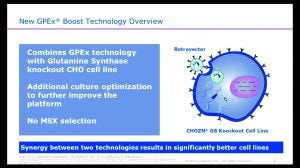- Sponsored Content
GPEx Boost: A Novel Approach for High-Expressing CHO Cell-Line EngineeringGPEx Boost: A Novel Approach for High-Expressing CHO Cell-Line Engineering
August 27, 2020
Sponsored by Catalent
 Gregory Bleck, PhD, global head of R&D, biologics, Catalent
Gregory Bleck, PhD, global head of R&D, biologics, Catalent
Catalent’s GPEx Boost technology, based on the company’s GPEx technology, is used for engineering high-expressing Chinese hamster ovary (CHO) cells for pharmaceutical production. Using replication and retrovector technology, genes are inserted into mammalian cell lines. The process requires neither antibiotic selection nor use of toxic compounds for gene amplification to make genetically stable cell lines, so stability testing can be kept off of the critical path for some programs. To date, 13 commercially approved products are manufactured by Catalent’s partners using GPEx cell lines.
Bleck’s presentation focused on a collaboration with a large pharmaceutical partner to compare the GPEx system with its internal cell-line development system — a traditional system using selectable markers and gene amplification. The client wanted to produce stable, high-expressing cell lines, so it isolated 360 individual clones from each of two pooled cell lines, a GPEx pool and a traditional pool it had generated. The GPEx cell lines expressed protein at fairly high levels, whereas about half of the cells isolated from the traditional pool did not express the product or expressed at low levels. After further analysis, the partner confirmed that the best GPEx clones expressed 3.5–4 g/L, but its best clones expressed in the 2–2.5 g/L range. Stability analysis shows that the top 12 traditional clones were unstable, whereas all the 12 GPEx clones were stable.
GPEx Boost technology, like the GPEx technology it’s based on, uses retrovector gene insertion — in this case, into the CHOZN GS knockout cell line from Merck Millipore, thereby combining GPEx with a traditional glutamine synthetase (GS)-type knockout system. The method uses no methionine sulfoximine (MSX) selection; the only selection performed is for GS by removing glutamine from the process. Illustrating a synergy between the two approaches, Bleck showed how the GPEx Boost technology led to a significantly higher expression and specific productivity per copy of the gene inserted.
He next described three experiments expressing three different proteins: a hard-to-express FC fusion protein, a hard-to-express IgG 1 antibody, and a medium-to-high–expressing IgG-1 antibody product. For the FC fusion product, the GPEx Boost pool performed substantially better. Specific productivities were significantly higher (~threefold) for the GPEx Boost pool. For the low-expressing antibody comparison, the team looked at the total gene copy index. Although the total gene copy number was relatively consistent between the two pools, they saw a significant increase in expression with the GPEx Boost pool — ~1.8 g/L compared with 0.6 g/L, a twofold increase in specific productivity. With the medium-to-high–expressing antibody, the GPEx Boost pool expressed at a little over 3.5 g/L, which was a dramatic increase in titer.
He explained what was occurring in the pools, and then spoke about analyzing the stability of GPEx Boost cell lines. GPEx Boost pools for two antibodies were evaluated through a 40-generation stability study, with titers evaluated at different time points. Little to no change was seen in the production level for either antibody over those generations.
Catalent’s goal is to help shorten and improve efficiencies in the biologics development timeline, and this technology already is being used to speed development of COVID-19 products into the clinic. Catalent uses microfluidics (the Berkeley Lights Beacon system) to identify and isolate high-expressing clonal cell lines quickly. The top 12 of (typically) 1,500 clones are selected and expanded in ambr 15 miniature bioreactors at four different conditions for a quick read on their responses to media and feeds. The best clone and best conditions then are scaled up directly into single-use bioreactors, Catalent’s base program.
To speed the development timeline, a cell-line technology produce high yields because products (especially for treatment of COVID-19) will be needed in large quantities. The selected cell-line technology must produce results quickly and provide a genetically stable cell line to keep stability study off the critical path. Bleck concluded that GPEx Boost technology produces significantly higher titers than does traditional GPEx technology. Difficult-to-express proteins work particularly well with the system, reaching up to 4× higher titers from stable pooled cell lines.
Watch the complete presentation now.
You May Also Like






